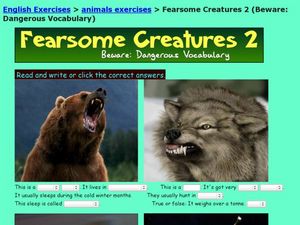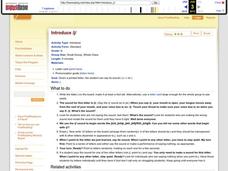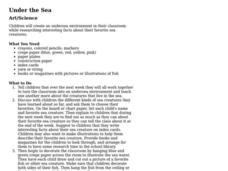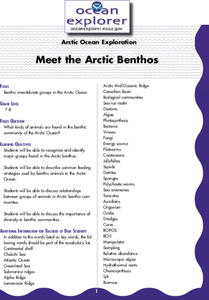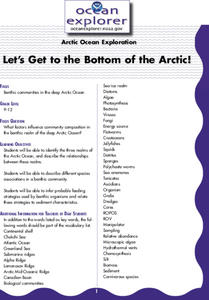Curated OER
Surface Area to Volume Ratio
Students examine the surface area to volume ratio and how they relate. In this surface area lesson students complete several activities.
Curated OER
Coral Bleaching
High schoolers examine the relationship between corals and zooxanthellae, identify stresses to corals, and explain coral bleaching. In this sea life lesson students predict the effects of increased temperatures on coral reefs.
Curated OER
I Have a Friend Who?
For this word puzzle worksheet, students find the pattern in two word lists (likes/dislikes).
Curated OER
Sponges and Cnidarian Crossword Puzzle
For this marine science worksheet, students complete a crossword puzzle with 32 questions on sponges and cnidarian. They identify the different characteristics of sponges and cnidarian.
Curated OER
Fearsome Creatures 2
In this fearsome creatures worksheet, students choose the correct words to fill in the blanks to sentences about dangerous animals. Students complete this for 10 animals.
Curated OER
ESL: Sea Animals Activity
For this ESL sea animals worksheet, students watch a video about sea animals, then identify names of animals shown in pictures.
Curated OER
Animals
In this animals worksheet, students look at pictures of animals and decide the correct name of the animal and write sentences that start with "this is a" or "this is an". Students complete 2 activities.
Curated OER
Immersion Presents Monterey Bay
Students study Monterey Bay. In this Monterey Bay lesson, students create a model of upwelling around Monterey Bay. Students simulate surface water movement relative to prevailing winds.
Curated OER
Introduce /J/
Students determine how to write and say the sound of /j/. In this letter identification lesson, students practice making the /j/ sound and write the letter after seeing it modeled. They locate the letter /j/ among others when they are...
Curated OER
Under the Sea
Students create an undersea environment in their classroom while researching interesting facts about their favorite sea creatures. They create illustrations to decorate their classroom and transform it into an undersea environment.
Curated OER
Create an Underwater Scene
Students apply knowledge of underwater ocean life by creating an ocean life scene with marine animals and plants placed at appropriate ocean depths.
Curated OER
Meet the Arctic Benthos
Learners recognize and identify major groups found in the Arctic benthos. They describe common feeding strategies used by benthic animals in the Arctic Ocean. They discuss relationships between
Curated OER
Let's Get to the Bottom of the Arctic!
Students identify the three realms of the Arctic Ocean, and describe the relationships between these realms. They describe different species associations in a benthic community.
Curated OER
It's All Relative
Students find pictures of living things and arrange them in collages, categorizing them according to which they think are more closely related to which.
Curated OER
Spongebob Squarepants Tag
Students role-play Spongebob Squarepants characters while participating in a P.E. tag game.
Curated OER
Tackling Taxonomy
Learners study physical characteristics of separate phyla and place them into similar groups. This lesson is part of a multi-segmented unit on the diversity of life. students develop a classification system by grouping animals into...
Curated OER
Creatures That Glow In The Night
Students investigate the different bioluminescent organisms. They use microscopes in order to make observations and draw what is seen. Students demonstrate they have studies the differences between the process of photosynthesis and...
Curated OER
Light My Fire ...Fly
High schoolers examine fire flies. They measure the frequency of light stimulus used by communicating fire flies. Students explore the concept of organisms using light to communicate. High schoolers film the fire flies and quantify...
Curated OER
Not Just For A Baby's Bottom
Eighth graders investigate the presence of talc in the geologic record. The different characteristics of talc is covered. The lesson includes background information for the teacher.
Curated OER
Deep Sea Fishing for Facts
Third graders read each question and click on the Web link located next to it. They find the answer to the question and type in their answer below the questions. When finished, they print off their page and turn it in.
Curated OER
Classification
In this biology worksheet, students identify and locate various vocabulary terms related to the classification of living things. There are 32 biology terms located in the word search.
Curated OER
Animal Word Search by Hannah Sutherland
In this student made animal word search activity, students search for animal words hidden within the puzzle. They search for words such as butterfly, koala, meerkat, and whale.
Curated OER
Who Am I?
In this science worksheet, students examine 16 detailed pictures of different species of marine invertebrates. Students identify each species. There is no room to write the name under the picture. It is assumed this is an oral activity,...
Curated OER
Shadow Know-How
In this fill in the blank worksheet, students identify the names of
twelve different seashore creatures by analyzing their outlines in shadow
pictures.
Other popular searches
- Jellyfish Worksheets
- Jellyfish Body Parts
- Jellyfish Dissection
- Genus Jellyfish
- Sponges and Jellyfish
- Poems About Jellyfish
- Paper Jellyfish
- Dissect Jellyfish
- Giant Jellyfish Invasion
- Medusa Jellyfish
- Corals and Jellyfish
- Dissect Jellyfish Diagram






